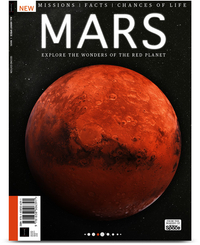National Geographic's 'Built for Mars' will let you tag along with NASA's Perseverance Mars rover landing

An intrepid NASA rover is bearing down on Mars for an epic landing on Thursday (Feb. 18) and a new National Geographic documentary will let you share in the excitement of the mission, which aims to seek signs of ancient life and perhaps help return samples to Earth in the future.
The NASA Perseverance rover will endure a new "seven minutes of terror" sequence Thursday (Feb. 18) to target the right spot on the Red Planet's surface in Jezero Crater and touch down within driving distance of a former river delta that may host remains of Martian microbes. The rover will cache the most promising samples to kick off a sample-return mission to Earth later in the decade.
It wasn't an easy journey to get even this far, as the new National Geographic show "Built for Mars: The Perseverance Rover" recalls. (The show will premiere at 8 p.m. EST or 7 p.m. CST on Thursday; check local listings for more details in your time zone or country.)
You can watch the Mars landing live here and on Space.com's homepage, courtesy of NASA, beginning at 2:15 p.m. EST (1915 GMT). The landing is expected at 3:55 p.m. EST (2055 GMT).
Related: How to watch NASA's Perseverance rover land on Mars
Perseverance rover's Mars landing: Everything you need to know
Book of Mars: $22.99 at Magazines Direct
Within 148 pages, explore the mysteries of Mars. With the latest generation of rovers, landers and orbiters heading to the Red Planet, we're discovering even more of this world's secrets than ever before. Find out about its landscape and formation, discover the truth about water on Mars and the search for life, and explore the possibility that the fourth rock from the sun may one day be our next home.
The rover's launch in July 2020 unexpectedly took place in the middle of a global pandemic that erupted months before, requiring physical distancing never before needed during the era of space exploration. The show, National Geographic Channel said in a statement, "shines a spotlight on the essential but little-known role of the flight technicians — the mechanics, machinists, and other hands-on workers who are entrusted with the crucial job of turning the scientists' goals and the engineers' designs into reality, with one-of-a-kind hardware built for Mars."
NASA also brought some of those behind-the-scenes voices to the fore in interviews this month. Among those was NASA's deputy project scientist for the Perseverance mission, Ken Williford, who told Space.com where Perseverance's mission fits into future sample-return plans.
Get the Space.com Newsletter
Breaking space news, the latest updates on rocket launches, skywatching events and more!
"Mars 2020 is the first part of what would be a multi-mission sample-return campaign," Williford said, using the Perseverance mission's original designation. "Our job is to select and collect the best possible samples in our exploration area, and then place them safely on the surface of Mars. And then some follow-on missions that could launch as early as 2026 would be required to go and pick up our samples, get them into Mars' orbit, and then … fly them back to Earth."
Earth is a perfect location to study Mars rocks. On missions to the Martian surface, the logistics of spaceflight constrain how much scientific equipment engineers can send to the surface of the Red Planet. But sample return would be a difficult mission that also requires additional procedures to protect us from any potential Martian microbes.
But Williford said any evidence of Martian life would be useful to put Earth's life in context. "We have a great fossil record of life on Earth that extends all the way back to about 3.5 billion years ago," he said. At that time, organisms called stromatolites built microbial mats that have fossilized. "They're these wrinkly layered structures that are preserved in the rocks."
That said, we would need to be absolutely sure that any evidence of Martian life cannot be explained by other processes not related to life, Williford cautioned. "We would require particularly extraordinary evidence. [But] we're quite confident that … we could observe something like this, which would really, absolutely have us jumping up and down with excitement," he said.
When Martian samples arrive on Earth, NASA and its partners will take an abundance of precautions to protect humanity from potential contamination, just as the agency did when it first gathered rocks from the moon. How this will happen is still an ongoing conversation, lead planetary protection engineer Moogega Cooper told Space.com, but we know the big-picture goal.
"I love to equate it to going to a national park where there's the Leave No Trace policy, right?" Cooper said of a rover like Perseverance alighting on the Martian surface. "When we go and explore different planets, including Mars, we want to make sure that we're not bringing any microbial hitchhikers with us that may contaminate the surface of Mars or may affect our science. And then the second part is, eventually we hope to bring the samples back. So we want to make sure that we protect our own Earth's biosphere from any inadvertent contamination, too."
Part of the discussion about returning samples will involve a number of checkpoint along the journey to Earth, Cooper said. "There are going to be a lot of checkpoints, and if it doesn't meet that safety checkpoint, it's not coming back," she said. "So at least, even though the conversations are ongoing, we could all be assured that everyone's trying to get this done in the best way possible, in the safest way possible."
Visit Space.com Thursday for complete coverage of the Perseverance Mars rover's landing on the Red Planet.
Follow Elizabeth Howell on Twitter @howellspace. Follow us on Twitter @Spacedotcom and on Facebook.
Join our Space Forums to keep talking space on the latest missions, night sky and more! And if you have a news tip, correction or comment, let us know at: community@space.com.

Elizabeth Howell (she/her), Ph.D., was a staff writer in the spaceflight channel between 2022 and 2024 specializing in Canadian space news. She was contributing writer for Space.com for 10 years from 2012 to 2024. Elizabeth's reporting includes multiple exclusives with the White House, leading world coverage about a lost-and-found space tomato on the International Space Station, witnessing five human spaceflight launches on two continents, flying parabolic, working inside a spacesuit, and participating in a simulated Mars mission. Her latest book, "Why Am I Taller?" (ECW Press, 2022) is co-written with astronaut Dave Williams.

